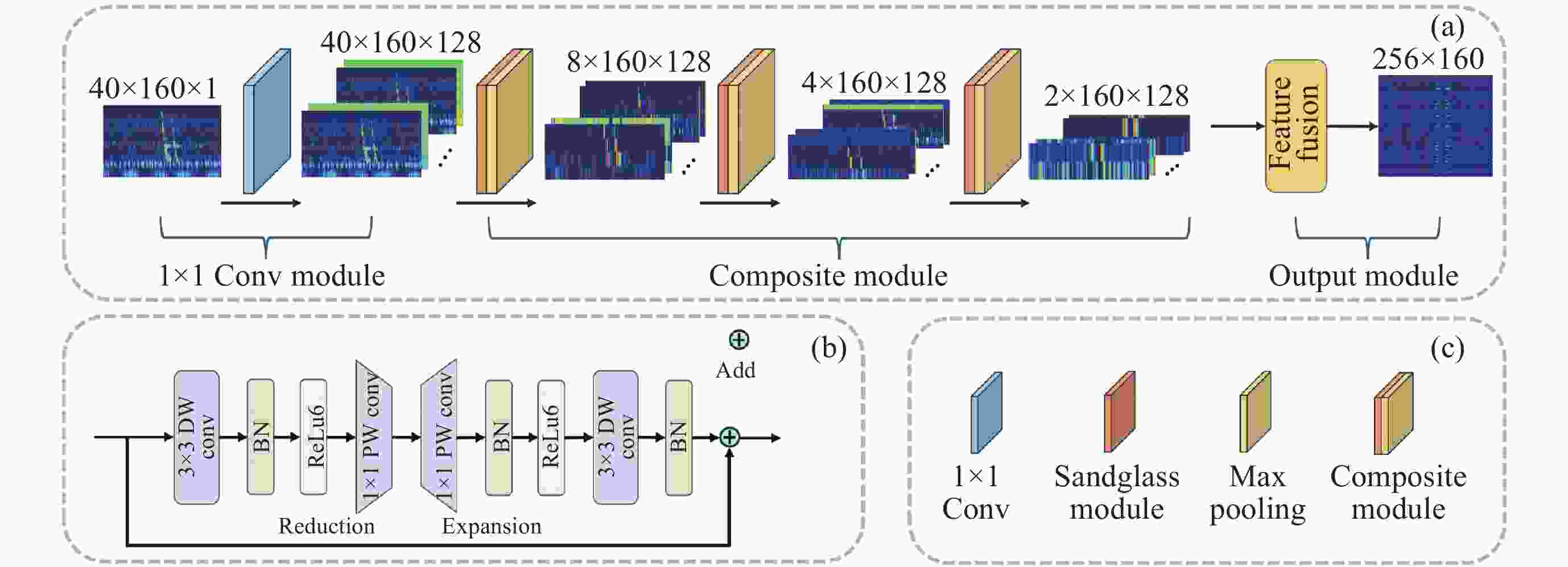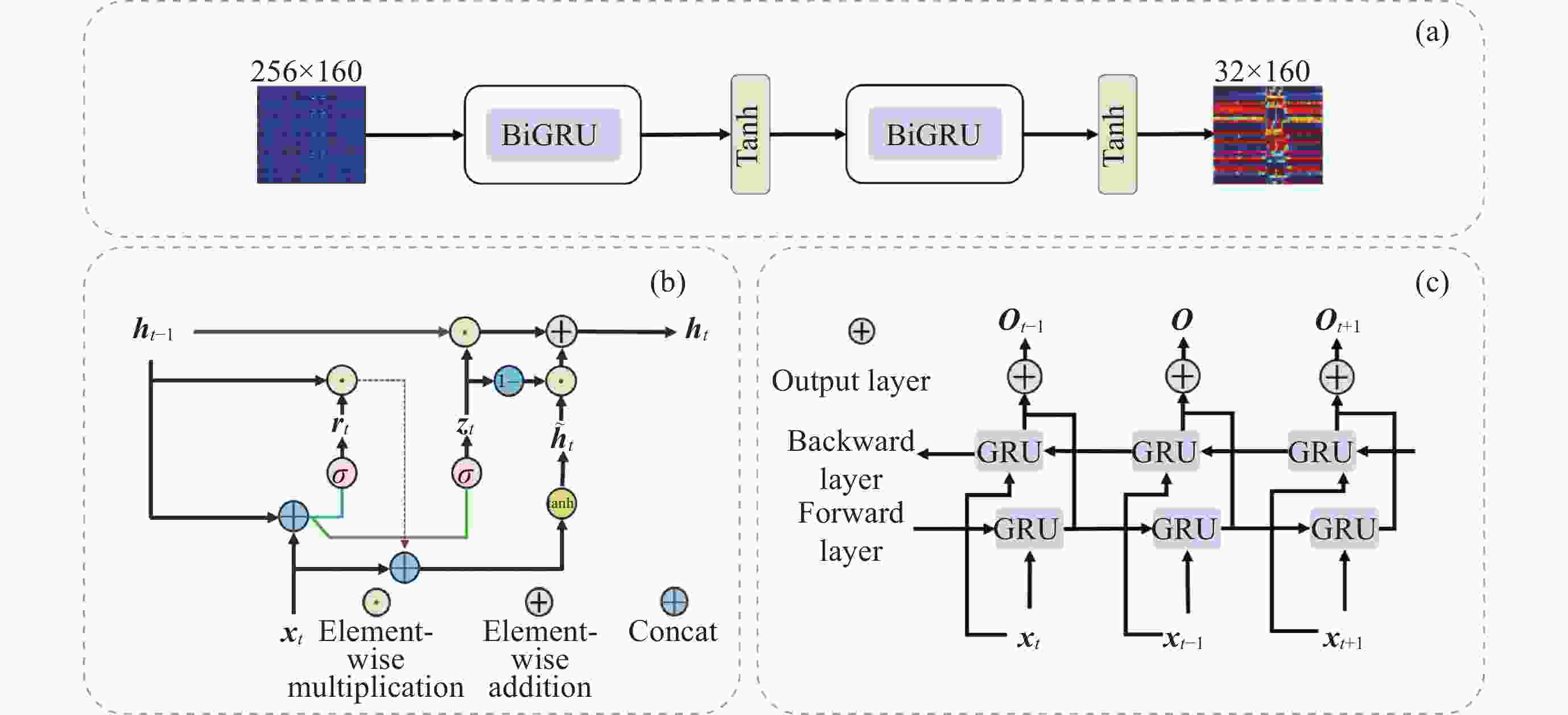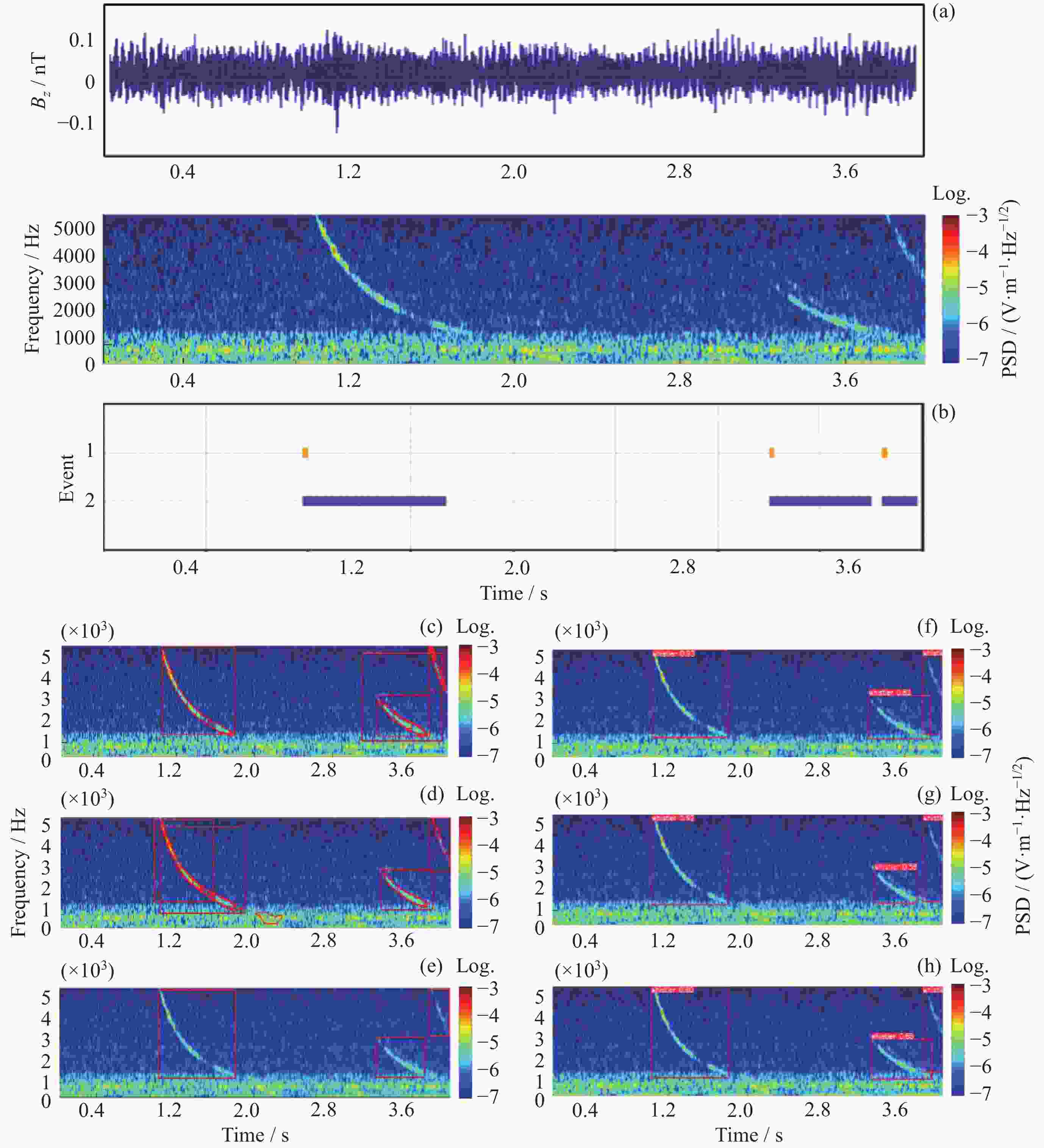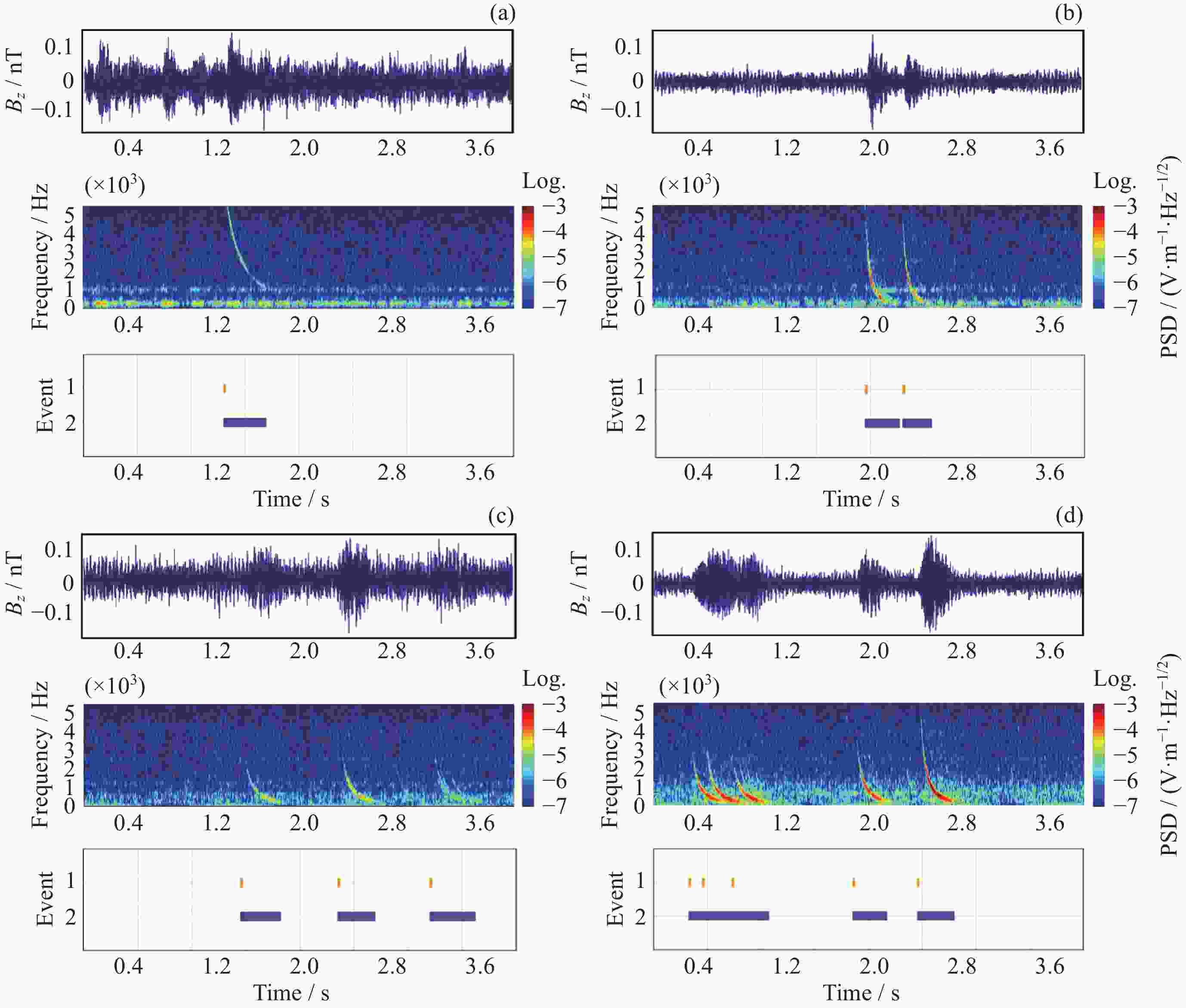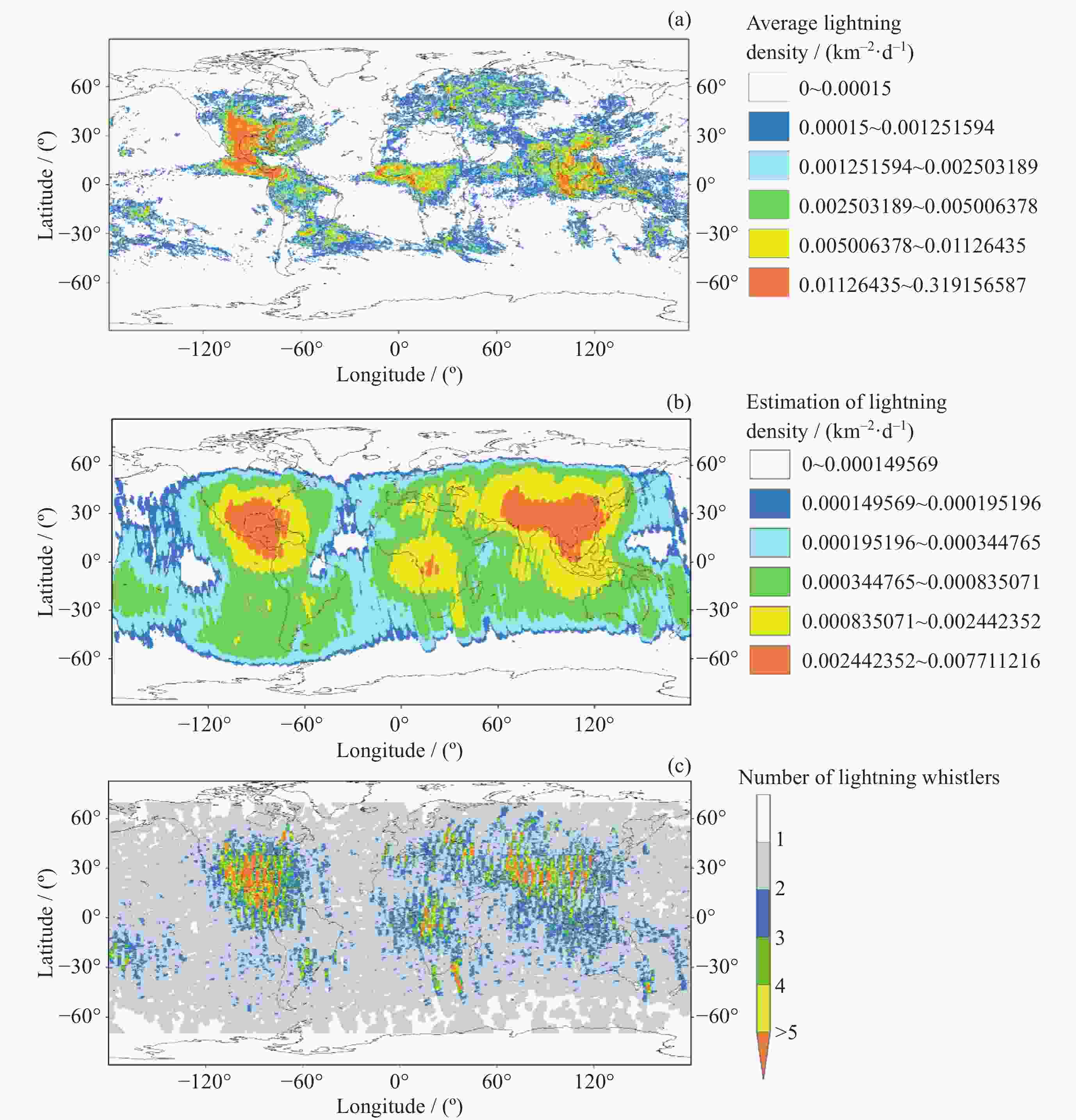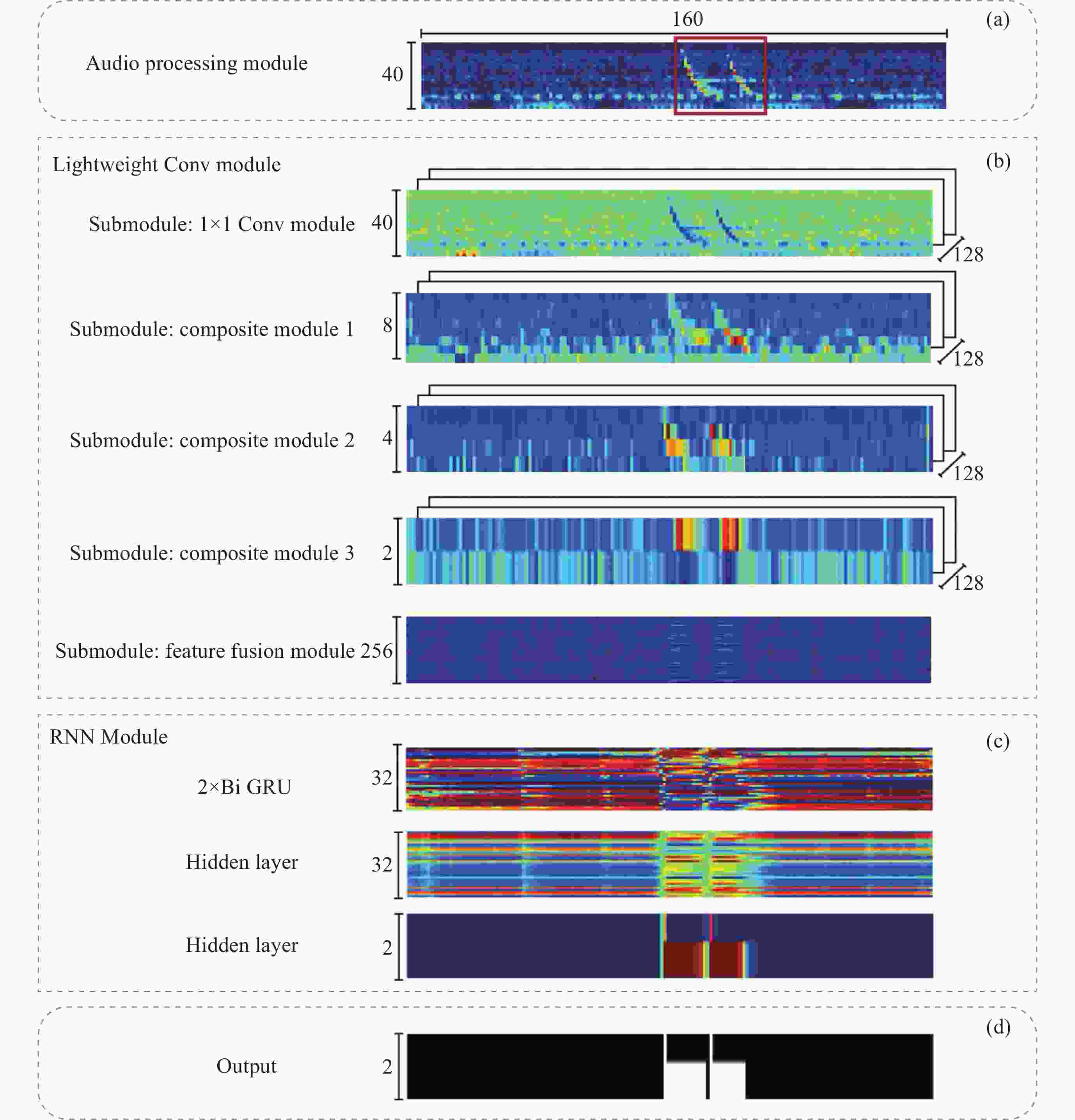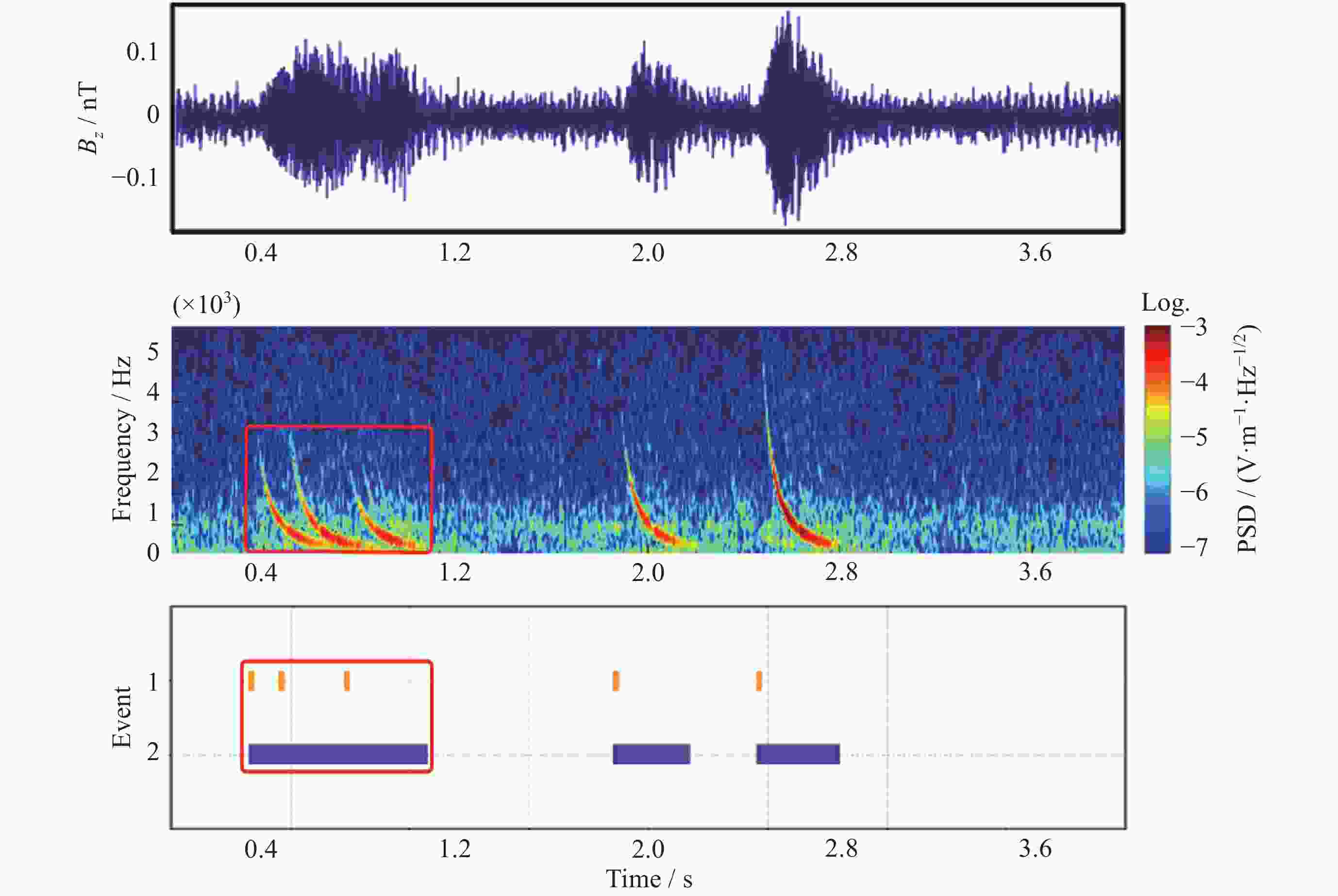A Robust and High-speed Automated Detection Model for Lightning Whistler
-
摘要: 张衡一号卫星在轨6年积累了海量观测数据, 检测其中的闪电哨声波事件(Lightning Whistler, LW)对于分析空间物理环境规律具有重要意义. 但现有基于时频图像的方法推理速度过慢, 完成任务需约40年. 为此, 研究首次从音频事件检测的角度提出高速的闪电哨声波检测模型WhisNet, 将检测的时间成本从40年压缩至54天. 方法为以4 s滑动窗截取波形, 提取梅尔频谱特征, 利用轻量级卷积循环神经网络(CRNN)提取音频事件特征, 输出层预测LW事件起始时间和持续时长. 基于2020年4月1-10日的感应磁力仪(SCM)数据实验显示, WhisNet检测性能与传统方法相当, 但计算量和参数量减少99%, 速度提升98%. 进一步在2020年5月SCM数据上的应用结果与WGLC (全球闪电气候学和时间序列, WWLLN Global Lightning Climatology and time series)全球闪电密度趋势高度一致, 验证了WhisNet在大规模卫星数据处理中的准确性与适用性. 研究结果为挖掘其他海量地球空间事件提供了重要参考.Abstract: The Zhangheng Satellite has accumulated a vast amount of observational data over its six years in orbit. Detecting all Lightning Whistler (LW) events from this dataset is crucial for comprehensively analyzing the variation patterns of the space physical environment. However, using the current mainstream LW detection technology, which is based on time-frequency spectrograms, it would take approximately 40 years to complete this task. To address the slow inference speed and meet practical engineering demands, this study proposes, for the first time, a high-speed detection model for lightning whistler waves from the perspective of audio event detection — WhisNet. This model reduces the time cost from 40 years to just 54 days. First, waveform data is segmented using a 4-second sliding window; then, Mel-spectrogram audio features are extracted. Next, a lightweight Convolutional Recurrent Neural Network (CRNN) is constructed to further extract the audio event features of LW. Finally, two fully connected networks are created at the output layer to predict the start time and duration of each LW event. To evaluate the model’s performance and computational speed, experiments were conducted on data from the SCM (Search Coil Magnetometer) between April 1 and April 10, 2020. The results show that the performance of the WhisNet model is comparable to that of time-frequency image-based methods, but with a 99% reduction in computational and parameter costs and a 98% increase in computational speed. The model was further applied to SCM data from May 2020, and the detection results were statistically analyzed and visually compared to the average lightning density trend from the WWLLN Global Lightning Climatology and time series (WGLC) for May 2020. The high consistency between the two further confirms the applicability and accuracy of the WhisNet model in processing large-scale satellite data. This method offers significant reference value for thoroughly exploring other large-scale geospace events.
-
图 6 不同模型检测哨声波的效果. (a)原始波形与时频图, (b) WhisNet, (c) Mask R-CNN, (d) Mask scoring R-CNN, (e) YOLOv5-Upgraded, (f) YOLOv8s, (g) YOLOv8m, (h) YOLOv8l
Figure 6. Performance of different models in detecting whistlers. (a) Original image, (b) WhisNet, (c) Mask R-CNN, (d) Mask scoring R-CNN, (e) YOLOv5-Upgraded, (f) YOLOv8s, (g) YOLOv8m, (h) YOLOv8l
图 8 模型实际应用情况. (a) WGLC在2020年5月份的平均闪电密度, (b) WhisNet模型自动检测张衡卫星LW的密度估计, (c) Kriging插值法
Figure 8. Practical application. (a) Average lightning density in May 2020 recorded by WGLC, (b) density estimation of lightning whistlers from the Zhangheng Satellite LW detected automatically by WhisNet, (c) Kriging interpolation method
图 9 各模块输出的特征. (a)音频处理模块, (b)轻量化卷积模块, (c)循环神经网络模块, (d)输出模块. 图中数字表示相应特征图的维度
Figure 9. Feature maps output by each module. (a) Audio processing module, (b) lightweight convolutional module, (c) recurrent neural network module, (d) output module. The numbers indicate the corresponding dimensions of the feature maps
表 1 模型超参数
Table 1. Hyperparameters of the model
超参数 值 损失函数 Binary Cross Entropy Loss 优化器 Adam 学习率 0.001 批大小 128 训练轮次 50 表 2 模型性能评估
Table 2. Performance evaluation of the model
Model Precision/(%) Recall/(%) F1/(%) FLOPS/GByte Params /MByte Cost time/h WhisNet 93.3 89.4 91.3 0.17 0.09 18.15 Mask R-CNN 85.1 95.2 89.8 144 44.32 842.16 Mask Scoring R-CNN 85.2 96.3 90.2 181 62.75 935.61 YOLOv5-Upgraded 91.6 90.0 90.8 31.7 13.78 579.86 YOLOv8s 91.3 90.1 90.6 28.6 11.2 574.43 YOLOv8m 92.5 89.9 91.2 78.9 25.9 591.82 YOLOv8l 94.0 88.8 91.3 165.2 43.7 622.61 注 表中加粗的数字表示该指标下的最佳结果. 表 3 生成单个特征所需时间
Table 3. Time to generate a single feature
特征名称 Time/s Size/kByte Mel频谱 0.003 25 时频图 1.7 165 -
[1] STOREY L R O. An investigation of whistling atmospherics[J]. Philosophical Transactions of the Royal Society of London. Series A, Mathematical and Physical Sciences, 1953, 246(908): 113-141 doi: 10.1098/rsta.1953.0011 [2] HELLIWELL R A. Whistlers and related ionospheric phenomena[J]. Geophysical Journal International, 1966, 11(5): 563-564 doi: 10.1111/j.1365-246x.1966.tb03172.x [3] SMITH R L, HELLIWELL R A, YABROFF I W. A theory of trapping of whistlers in field-aligned columns of enhanced ionization[J]. Journal of Geophysical Research, 1960, 65(3): 815-823 doi: 10.1029/JZ065i003p00815 [4] EDGAR B C. The Structure of the Magnetosphere as Deduced from Magnetospherically Reflected Whistlers [R]. No. NSSDC-ID-66-049A-17-PM. Greenbelt, MD: NASA National Space Science Data Center, 1972 [5] Walker A D M. The theory of whistler propagation[J]. Reviews of Geophysics, 1976, 14(4): 629-638 doi: 10.1029/RG014i004p00629 [6] TANG R X, YUAN A, LI H M, et al. Influence of solar wind dynamic pressure on distribution of whistler mode waves based on van Allen probe observations[J]. Journal of Geophysical Research: Space Physics, 2023, 128(4): e2022JA031181 doi: 10.1029/2022JA031181 [7] WOODFIELD E E, GLAUERT S A, MENIETTI J D, et al. Rapid electron acceleration in low-density regions of Saturn’s radiation belt by whistler mode chorus waves[J]. Geophysical Research Letters, 2019, 46(13): 7191-7198 doi: 10.1029/2019GL083071 [8] WOODFIELD E E, GLAUERT S A, MENIETTI J D, et al. Acceleration of electrons by whistler-mode hiss waves at Saturn[J]. Geophysical Research Letters, 2022, 49(3): e2021GL096213 doi: 10.1029/2021GL096213 [9] SANTOLÍK O, PARROT M, INAN U S, et al. Propagation of unducted whistlers from their source lightning: a case study[J]. Journal of Geophysical Research: Space Physics, 2009, 114(A3): A03212 doi: 10.1029/2008JA013776 [10] ZHOU Huaibei, XIAO Zuo, SUN Chuanli. A study of cloud-earth lightning parameters by using whistler spectrum[J]. Chinese Journal of Radio Science, 1989, 4(1): 1-7 (周怀北, 肖佐, 孙传礼. 根据哨声频谱反演云—地闪电参数[J]. 电波科学学报, 1989, 4(1): 1-7ZHOU Huaibei, XIAO Zuo, SUN Chuanli. A study of cloud-earth lightning parameters by using whistler spectrum[J]. Chinese Journal of Radio Science, 1989, 4(1): 1-7 [11] CHEN Y P, NI B B, GU X D, et al. First observations of low latitude whistlers using WHU ELF/VLF receiver system[J]. Science China Technological Sciences, 2017, 60(1): 166-174 doi: 10.1007/s11431-016-6103-5 [12] CARPENTER D L, ANDERSON R R. An ISEE/whistler model of equatorial electron density in the magnetosphere[J]. Journal of Geophysical Research: Space Physics, 1992, 97(A2): 1097-1108 doi: 10.1029/91JA01548 [13] SINGH A K, VERMA U P, BHARGAWA A. Remote sensing of mid/upper atmosphere using ELF/VLF waves[J]. Global Journal of Science Frontier Research: A Physics and Space Science, 2018, 18(10): 11-21 [14] OIKE Y, KASAHARA Y, GOTO Y. Spatial distribution and temporal variations of occurrence frequency of lightning whistlers observed by VLF/WBA onboard Akebono[J]. Radio Science, 2014, 49(9): 753-764 doi: 10.1002/2014RS005523 [15] BAYUPATI I P A, KASAHARA Y, GOTO Y. Study of dispersion of lightning whistlers observed by Akebono satellite in the Earth’s plasmasphere[J]. IEICE Transactions on Communications, 2012, E95. B(11): 3472-3479. DOI: 10.1587/transcom.E95.B.3472 [16] CLILVERD M A, NUNN D, LEV-TOV S J, et al. Determining the size of lightning-induced electron precipitation patches[J]. Journal of Geophysical Research: Space Physics, 2002, 107(A8): SIA10 doi: 10.1029/2001JA000301 [17] KISHORE A, DEO A, KUMAR S. Upper atmospheric remote sensing using ELF-VLF lightning generated tweek and whistler sferics[J]. The South Pacific Journal of Natural and Applied Sciences, 2016, 34(1): 12-20 doi: 10.1071/sp16002 [18] PARROT M, PINÇON J L, SHKLYAR D. Short-fractional hop whistler rate observed by the low-altitude satellite DEMETER at the end of the solar cycle 23[J]. Journal of Geophysical Research: Space Physics, 2019, 124(5): 3522-3531 doi: 10.1029/2018JA026176 [19] HORNE R B, GLAUERT S A, MEREDITH N P, et al. Space weather impacts on satellites and forecasting the Earth’s electron radiation belts with SPACECAST[J]. Space Weather, 2013, 11(4): 169-186 doi: 10.1002/swe.20023 [20] LINZMAYER V, NĚMEC F, SANTOLÍK O, et al. Lightning-induced energetic electron precipitation observed in long-term DEMETER spacecraft measurements[J]. Journal of Geophysical Research: Space Physics, 2024, 129(8): e2024JA032713 doi: 10.1029/2024JA032713 [21] FEINLAND M, BLUM L W, MARSHALL R A, et al. Lightning-induced relativistic electron precipitation from the inner radiation belt[J]. Nature Communications, 2024, 15(1): 8721 doi: 10.1038/s41467-024-53036-4 [22] LICHTENBERGER J, FERENCZ C, BODNÁR L, et al. Automatic whistler detector and analyzer system: automatic whistler detector[J]. Journal of Geophysical Research: Space Physics, 2008, 113(A12): A12201 doi: 10.1029/2008JA013467 [23] STANFORD VLF GROUP. Automated Detection of Whistlers for the TARANIS Space[R]. Stanford, CA: Stanford University, 2009 [24] DHARMA K S, BAYUPATI I P A, BUANA P W. Automatic lightning whistler detection using connected component labeling method[J]. Journal of Theoretical and Applied Information Technology, 2014, 66(2): 638-645 [25] KONAN O J E Y, MISHRA A K, LOTZ S. Machine learning techniques to detect and characterise whistler radio waves[OL]. arXiv: 2002.01244. (2020-02-04) [2023-10-15]. https://arxiv.org/abs/2002.01244. DOI: 10.48550/arXiv.2002.01244 [26] YUAN Jing, WANG Qiao, YANG Dehe, et al. Automatic recognition algorithm of lightning whistlers observed by the Search Coil Magnetometer onboard the Zhangheng-1 Satellite[J]. Chinese Journal of Geophysics, 2021, 64(11): 3905-3924 (袁静, 王桥, 杨德贺, 等. 张衡一号感应磁力仪数据闪电哨声波自动识别[J]. 地球物理学报, 2021, 64(11): 3905-3924 doi: 10.6038/cjg2021O0164YUAN Jing, WANG Qiao, YANG Dehe, et al. Automatic recognition algorithm of lightning whistlers observed by the Search Coil Magnetometer onboard the Zhangheng-1 Satellite[J]. Chinese Journal of Geophysics, 2021, 64(11): 3905-3924 doi: 10.6038/cjg2021O0164 [27] PATAKI B Á, LICHTENBERGER J, CLILVERD M, et al. Monitoring space weather: using automated, accurate neural network based whistler segmentation for whistler inversion[J]. Space Weather, 2022, 20(2): e2021SW002981 doi: 10.1029/2021SW002981 [28] HARID V, LIU C, PANG Y, et al. Automated large-scale extraction of whistlers using mask-scoring regional convolutional neural network[J]. Geophysical Research Letters, 2021, 48(15): e2021GL093819 doi: 10.1029/2021GL093819 [29] LU Chao, ZEREN Zhima, YANG Dehe, et al. Lightweight automatic detection model for lightning whistle waves based on improved YOLOv5[J]. Chinese Journal of Space Science, 2024, 44(3): 458-473 (路超, 泽仁志玛, 杨德贺, 等. 改进YOLOv5的闪电哨声波轻量化自动检测模型[J]. 空间科学学报, 2024, 44(3): 458-473LU Chao, ZEREN Zhima, YANG Dehe, et al. Lightweight automatic detection model for lightning whistle waves based on improved YOLOv5[J]. Chinese Journal of Space Science, 2024, 44(3): 458-473 [30] YUAN Jing, WANG Zijie, ZEREN Zhima, et al. Automatic recognition algorithm of the lightning whistler waves by using speech processing technology[J]. Chinese Journal of Geophysics, 2022, 65(3): 882-897 (袁静, 王子杰, 泽仁志玛, 等. 基于智能语音技术的闪电哨声波自动识别[J]. 地球物理学报, 2022, 65(3): 882-897 doi: 10.6038/cjg2022P0365YUAN Jing, WANG Zijie, ZEREN Zhima, et al. Automatic recognition algorithm of the lightning whistler waves by using speech processing technology[J]. Chinese Journal of Geophysics, 2022, 65(3): 882-897 doi: 10.6038/cjg2022P0365 [31] ZEREN Z M, HU Y P, PIERSANTI M, et al. The seismic electromagnetic emissions during the 2010 Mw 7.8 Northern Sumatra Earthquake revealed by DEMETER satellite[J]. Frontiers in Earth Science, 2020, 8: 572393 doi: 10.3389/feart.2020.572393 [32] HUANG J P, LEI J G, LI S X, et al. The Electric Field Detector (EFD) onboard the ZH-1 satellite and first observational results[J]. Earth and Planetary Physics, 2018, 2(6): 469-478 doi: 10.26464/epp2018045 [33] KAPLAN J O, LAU K H K. The WGLC global gridded lightning climatology and time series[J]. Earth System Science Data, 2021, 13(7): 3219-3237 doi: 10.5194/essd-13-3219-2021 [34] MERMELSTEIN P. Distance Measures for Speech Recognition, Psychological and Instrumental[M]//CHEN C H. Pattern Recognition and Artificial Intelligence. New York: Academic Press, 1976: 374-388 [35] ZHOU D Q, HOU Q B, CHEN Y P, et al. Rethinking bottleneck structure for efficient mobile network design[C]//Proceedings of the 16th European Conference on Computer Vision. Glasgow: Springer, 2020: 680-697. DOI: 10.1007/978-3-030-58580-8_40 [36] HE K M, GKIOXARI G, DOLLÁR P, et al. Mask R-CNN[C]//Proceedings of the 2017 IEEE International Conference on Computer Vision. Venice: IEEE, 2017: 2980-2988 [37] HUANG Z J, HUANG L C, GONG Y C, et al. Mask scoring R-CNN[C]//Proceedings of the 2019 IEEE/CVF Conference on Computer Vision and Pattern Recognition. Long Beach: IEEE, 2019: 6402-6411 [38] ZHAO Shufan, LIAO Li, ZHANG Xuemin. Trans-ionospheric VLF wave power absorption of terrestrial VLF signal[J]. Chinese Journal of Geophysics, 2017, 60(8): 3004-3014 (赵庶凡, 廖力, 张学民. 地面VLF波穿透电离层的能量衰减变化[J]. 地球物理学报, 2017, 60(8): 3004-3014 doi: 10.6038/cjg20170809ZHAO Shufan, LIAO Li, ZHANG Xuemin. Trans-ionospheric VLF wave power absorption of terrestrial VLF signal[J]. Chinese Journal of Geophysics, 2017, 60(8): 3004-3014 doi: 10.6038/cjg20170809 [39] BALAN N, LIU L B, LE H J. A brief review of equatorial ionization anomaly and ionospheric irregularities[J]. Earth and Planetary Physics, 2018, 2(4): 257-275 doi: 10.26464/epp2018025 -
-





 银韩柯 男, 2000年11月出生, 现为防灾科技学院在读研究生, 主要研究方向为机器学习、计算机视觉. E-mail:
银韩柯 男, 2000年11月出生, 现为防灾科技学院在读研究生, 主要研究方向为机器学习、计算机视觉. E-mail: 

 下载:
下载:

